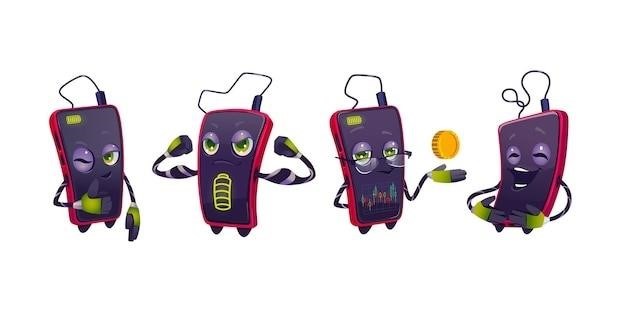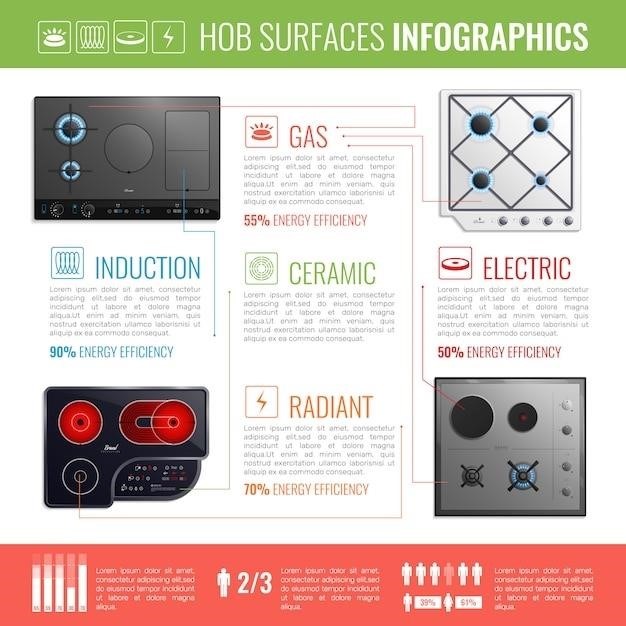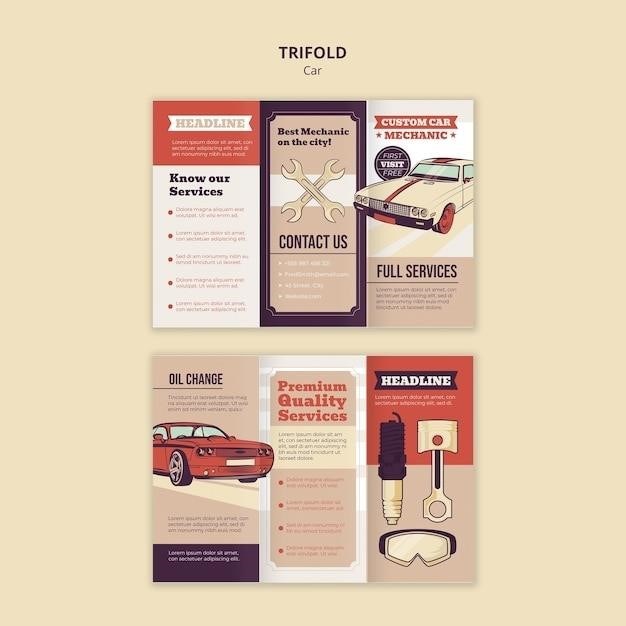Monster FM Transmitter Manuals⁚ A Comprehensive Guide
This guide provides a complete resource for Monster FM transmitter users․ Find manuals for various models‚ troubleshooting tips‚ pairing instructions‚ and safety information․ Learn to utilize features and understand FCC compliance․ Contact Monster support for further assistance․
Monster offers a range of FM transmitters designed to enhance your in-car audio experience․ These devices allow you to wirelessly stream music and other audio content from your smartphone‚ tablet‚ or other Bluetooth-enabled device to your car’s stereo system via an FM frequency․ Many models include additional features such as USB charging ports for convenient device power‚ hands-free calling capabilities for safe and easy communication while driving‚ and some even boast LED displays for easy viewing of frequency and status․ The ease of pairing with Bluetooth devices‚ along with their compact and user-friendly designs‚ makes Monster FM transmitters a popular choice for drivers seeking a seamless audio upgrade․ User manuals provide detailed instructions on setup‚ operation‚ and troubleshooting‚ ensuring a hassle-free and enjoyable listening experience․ Remember to consult your specific model’s manual for detailed instructions and safety precautions․
Popular Monster FM Transmitter Models and Their Manuals
Monster has produced several popular FM transmitter models‚ each with its own user manual․ The Monster RadioPlay 300‚ a frequently mentioned model‚ offers wireless FM transmission capabilities․ Its manual details setup‚ pairing‚ and basic operation․ Another model‚ the Monster iCarPlay Wireless 800‚ likely provides similar functionality but with potentially enhanced features․ Specific details regarding features vary by model‚ so consulting the respective manual is crucial․ These manuals are often available as PDF downloads from Monster’s website or third-party sources like ManualsLib․ The manuals typically cover aspects such as connecting to a car’s audio system‚ pairing with Bluetooth devices‚ using hands-free calling features (if available)‚ and troubleshooting common issues․ Key information such as specifications (frequency range‚ power output‚ etc․) and safety instructions are also included within these essential guides․ Always refer to your specific model’s manual for accurate and up-to-date information․
Accessing and Downloading Monster FM Transmitter Manuals
Locating and downloading your Monster FM transmitter manual is straightforward․ Begin by identifying your specific model number‚ often found on a label on the device itself․ This number is crucial for finding the correct manual․ Next‚ visit Monster’s official website․ Their support section typically houses a comprehensive library of user manuals‚ organized by product category and model number․ Use the search function on the website to locate your model quickly and efficiently․ Once found‚ you’ll likely find the manual available as a PDF file for download․ Alternatively‚ you may find it easier to utilize a third-party resource such as ManualsLib‚ a website dedicated to hosting user manuals from various manufacturers․ Simply search for your Monster FM transmitter model on ManualsLib‚ and if available‚ you can download the manual from there․ Remember to always verify the source to ensure you’re downloading a legitimate copy of the manual to avoid misinformation or potentially harmful files․ If you encounter difficulties accessing the manual through these methods‚ consider contacting Monster’s customer support directly for assistance․ They may be able to provide the manual electronically or direct you to an alternate reliable source․
Troubleshooting Common Issues with Monster FM Transmitters
Many common issues with Monster FM transmitters can be resolved with simple troubleshooting steps․ If you experience poor audio quality‚ start by checking the FM frequency on both your transmitter and car radio․ Ensure they precisely match; even a slight difference can lead to static or distorted sound․ Try adjusting the transmitter’s position within your vehicle; sometimes‚ interference from metal objects or other electronic devices can affect reception․ If the transmitter isn’t pairing with your Bluetooth device‚ ensure Bluetooth is enabled on both devices and that they are within a reasonable range of each other․ Try restarting both the transmitter and your Bluetooth device; sometimes‚ a simple reset can clear temporary glitches․ If you’re experiencing charging problems‚ check the USB port and cable for any damage or obstructions․ Try using a different USB cable or port to rule out a faulty connection․ For intermittent power issues‚ inspect the car’s cigarette lighter outlet to ensure it’s functioning correctly․ If none of these steps resolve your problem‚ consult the specific troubleshooting section within your Monster FM transmitter’s user manual for more detailed guidance‚ or contact Monster support for further assistance․ Remember to check for any error codes displayed on the transmitter‚ as these often indicate specific problems․

Pairing and Connecting Your Device to a Monster FM Transmitter
Pairing your Bluetooth device with a Monster FM transmitter is generally straightforward․ First‚ ensure your transmitter is powered on and in pairing mode․ This usually involves pressing and holding a specific button‚ often indicated by a Bluetooth symbol on the device itself․ Refer to your Monster FM transmitter’s user manual for precise instructions‚ as the method may vary depending on the model․ Once the transmitter is in pairing mode‚ it will typically begin flashing a blue LED light․ Next‚ activate the Bluetooth function on your smartphone or other Bluetooth-enabled device․ Look for the “available devices” or “nearby devices” list and search for your Monster FM transmitter; the name should be clearly displayed (e․g․‚ “Monster RadioPlay 300”)․ Select the transmitter from the list‚ and a pairing code may be required; typically‚ “0000” is used‚ but again‚ check your specific model’s manual․ Once the connection is established‚ a solid blue LED light‚ or a similar visual cue‚ will usually confirm the pairing․ After successful pairing‚ your audio should automatically stream through the transmitter to your car’s stereo system․ If audio isn’t playing‚ make sure your car radio is tuned to the same FM frequency as the transmitter․ Adjust the volume on both your device and the car radio for optimal sound․ For any persistent connection issues‚ consult your Monster FM transmitter’s user manual or contact Monster support for further assistance․
Utilizing the Features of Monster FM Transmitters
Monster FM transmitters offer a range of features beyond basic audio streaming․ Many models include multiple USB charging ports‚ allowing you to charge your phone or other devices while enjoying your music․ This convenient feature eliminates the need for separate car chargers․ Some Monster transmitters also incorporate hands-free calling functionality․ This enables you to answer and manage calls directly through the transmitter‚ enhancing safety while driving․ The inclusion of a built-in microphone and easily accessible buttons on the device makes this feature very user-friendly․ Furthermore‚ many Monster FM transmitters offer memory slots for storing your favorite FM frequencies․ This saves you the hassle of repeatedly searching for the optimal frequency each time you use the device․ The precise method for setting these memory slots varies across models; your user manual contains detailed instructions․ Some advanced models may include additional features such as LED displays that show the current FM frequency‚ battery level‚ or even song information․ Always refer to your specific Monster FM transmitter’s user manual for a complete understanding of its features and how to operate them effectively․ Understanding and utilizing these features will enhance your overall listening experience and provide a convenient and safe driving environment․
Safety Precautions and Important Information
Prioritize safe driving practices when using your Monster FM transmitter․ Avoid adjusting settings or making calls while actively driving; pull over to a safe location if adjustments are necessary․ Never disassemble the transmitter; internal components operate at high voltages and present a risk of electric shock․ Keep the transmitter away from direct sunlight or open flames‚ as extreme heat can damage the internal electronics․ The device should only be connected to a 12-24V power source‚ as using an incompatible voltage can permanently damage the unit․ Regularly inspect the cable connections for any signs of wear or damage‚ and replace any damaged parts immediately․ Avoid using the transmitter in environments with excessive moisture or dust; these conditions could compromise functionality and safety․ While using the hands-free calling feature‚ maintain awareness of your surroundings and drive cautiously․ The audio quality through the FM transmitter may vary depending on the signal strength and interference from other radio stations; experiment with different frequencies to find the clearest signal․ Ensure proper ventilation around the transmitter to prevent overheating․ Improper use can lead to malfunction or damage‚ potentially affecting your driving safety․ Always consult your specific Monster FM transmitter’s user manual for detailed safety instructions and guidelines before use․

FCC Compliance and Regulations for Monster FM Transmitters
Monster FM transmitters are designed to comply with Part 15 of the FCC rules․ Operation is subject to two conditions⁚ (1) the device must not cause harmful interference‚ and (2) the device must accept any interference received‚ including interference that may cause undesired operation․ These regulations are in place to ensure that the device operates within specified radio frequency emission limits to prevent interference with other electronic devices and communication systems․ Modifying or altering the transmitter in any way not explicitly authorized by Monster can void your FCC compliance and potentially result in legal repercussions․ The antenna should be positioned and adjusted to minimize radio frequency field emissions‚ adhering to Health Canada limits for general population exposure․ Failure to comply with these regulations may lead to the device’s confiscation or legal action․ Always refer to the specific FCC ID and related documentation included with your Monster FM transmitter to verify the precise compliance standards and any specific operational restrictions that apply to your model․ Understanding and adhering to these regulations is crucial for both legal operation and to minimize potential interference with other electronic devices․ Contact Monster support or refer to the FCC website for further information on compliance requirements and any potential regulatory updates․
Contacting Monster Support for Assistance
If you encounter issues with your Monster FM transmitter that you cannot resolve using the provided manual‚ contacting Monster support is your next step․ While specific contact information may vary depending on your region and the model of your transmitter‚ several avenues are typically available․ Check your product packaging or the included documentation for a customer service phone number‚ email address‚ or a link to a support website․ Monster’s website often contains a comprehensive FAQ section addressing common problems‚ troubleshooting guides‚ and potentially even video tutorials to assist you in resolving issues independently․ If you find yourself needing more direct support‚ utilize the provided contact channels․ When contacting support‚ have your transmitter’s model number readily available․ This will help them quickly identify your device and access the relevant technical specifications and troubleshooting information․ Clearly explain the problem you’re experiencing‚ including any error messages or unusual behavior you’ve observed․ Providing as much detail as possible will aid in a faster and more efficient resolution․ Remember to be polite and patient; support representatives deal with a large volume of inquiries․ Be prepared to provide proof of purchase if necessary‚ especially if you’re requesting warranty service or repair․


